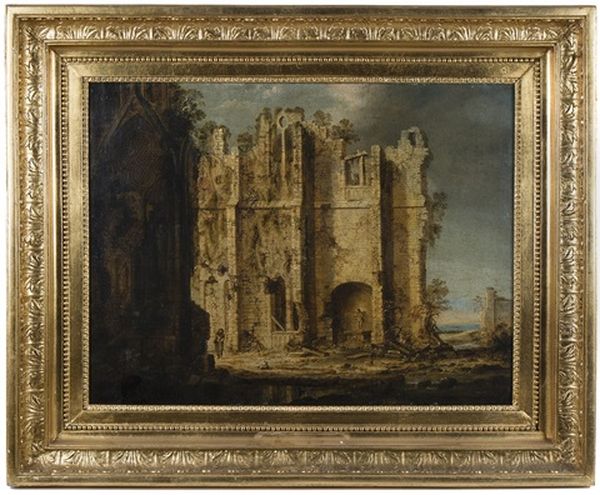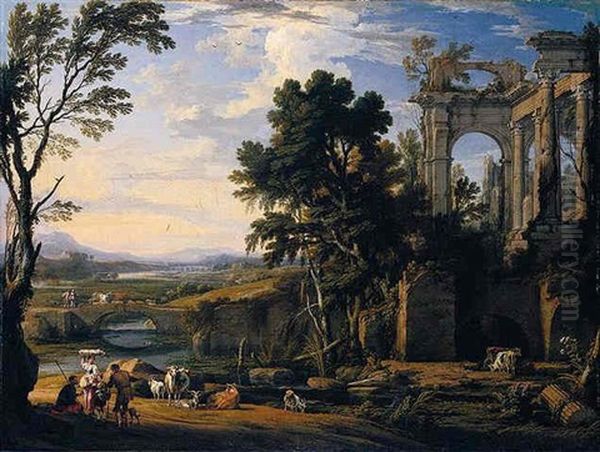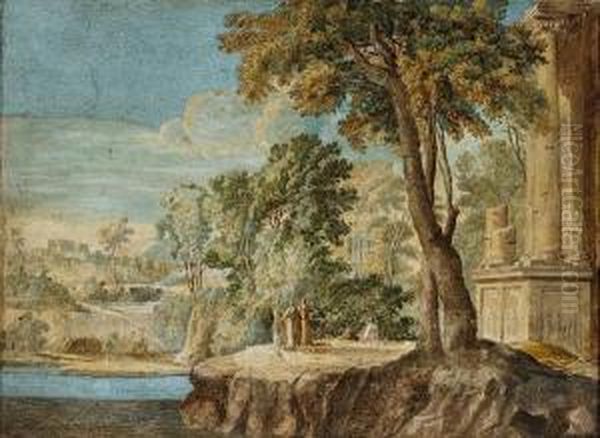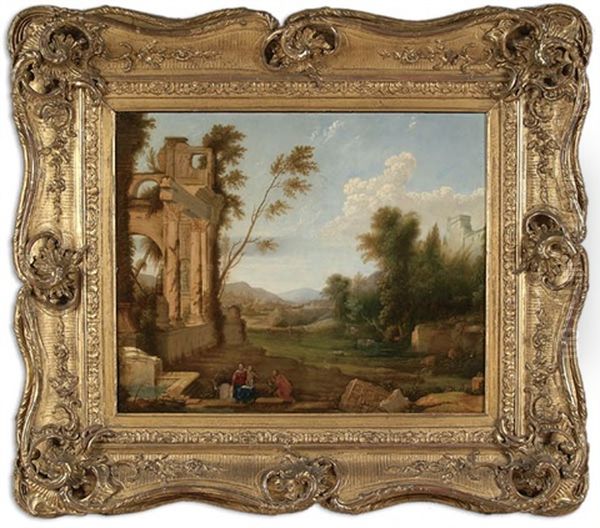Pierre Patel (1605-1676) stands as a significant, if sometimes overlooked, figure in the rich tapestry of 17th-century French art. A master of the classical landscape, his oeuvre is characterized by serene, meticulously composed scenes, often imbued with a melancholic beauty through the inclusion of ancient ruins and idyllic pastoral elements. Working in a period dominated by historical and religious painting, Patel carved a distinct niche for himself, drawing inspiration from Italianate traditions, particularly the work of Claude Lorrain, yet forging a style that was uniquely his own and deeply resonant with the aesthetic sensibilities of his time. His contributions to the decorative schemes of prominent Parisian residences and his connection to the royal court further underscore his importance in the artistic milieu of Grand Siècle France.
Early Life and Artistic Formation
Pierre Patel was born in 1605, with historical records suggesting his origins lie in the Picardy region of northern France, possibly in Chauny. Some accounts also mention Languedoc as a potential birthplace, indicating a degree of uncertainty that often surrounds the early lives of artists from this period. The region of Picardy, during Patel's formative years, was not untouched by the turmoil of conflict and the hardship of disease, experiences that may have subtly informed his later preoccupation with themes of transience and the enduring presence of nature and history, often symbolized by the crumbling edifices in his landscapes.
Details of Patel's initial artistic training are somewhat scarce, a common challenge when reconstructing the careers of artists before the full institutionalization of art education. However, it is known that by the early 1630s, he was active as a painter. An early influence often cited is that of the Flemish-born painter Jacques Fouquières (c. 1580/1590–1659), a landscape specialist who worked for the French court and was known for his naturalistic, though somewhat idealized, depictions of woodland scenes. This initial grounding may have provided Patel with a solid technical foundation in landscape representation before he gravitated towards a more classical and Italianate mode of expression.
Entry into the Parisian Art World

Patel’s professional career began to solidify in Paris during the 1630s. A significant step was his affiliation with the Corporation of Master Painters and Sculptors of Paris, often associated with the Académie de Saint-Luc, as opposed to the later, more prestigious Académie Royale de Peinture et de Sculpture founded in 1648. In 1633, he is recorded as having joined the guild of Saint-Germain-des-Prés, a community of artisans and artists. By 1634, he was recognized as a "maître peintre" (master painter), a designation that affirmed his professional standing. This was followed in 1635 by his official admission to the Académie de Saint-Luc, where he obtained a license to practice both painting and sculpture, although his surviving work is almost exclusively in painting.
During these early years in Paris, Patel began to establish connections within the city's vibrant artistic community. An early collaborator mentioned is Patrice Desmartins, a painter of Dutch origin. Such collaborations were common, allowing artists to share skills, undertake larger commissions, and navigate the competitive art market. It was also during this period that Patel likely came into the orbit of Simon Vouet (1590–1649), one of the most influential painters in Paris at the time.
The Influence of Simon Vouet and Eustache Le Sueur
Simon Vouet, upon his return from a successful career in Italy in 1627, became the Premier peintre du Roi (First Painter to the King) and transformed the Parisian art scene, introducing a lighter, more decorative Baroque style. While it's not definitively stated that Patel was a formal pupil in Vouet's extensive workshop, he certainly worked in close association with him and his circle. This connection proved pivotal. Vouet's studio was a training ground for a generation of French painters, and through this association, Patel developed a close working relationship with Eustache Le Sueur (1616–1655), one of Vouet's most gifted pupils.
Le Sueur, known for his gentle classicism and refined religious and mythological compositions, often collaborated with other artists on large decorative projects. The association between Patel and Le Sueur was particularly fruitful, most notably in their work on the decorative schemes for the Hôtel Lambert, a magnificent private residence in Paris. In such projects, it was common for figure painters like Le Sueur to collaborate with landscape specialists like Patel, each contributing their expertise to create a harmonious whole. Patel's landscapes would often serve as sophisticated backdrops or independent panels within these elaborate interiors. Vouet's influence can be seen in Patel's clear, bright palette and elegant compositions, while Le Sueur's classicizing tendencies would have resonated with Patel's own inclinations.
The Pervasive Influence of Claude Lorrain

While Vouet and his circle were instrumental in Patel's Parisian career, the most profound stylistic influence on his landscape painting came from Claude Gellée, known as Claude Lorrain (1600–1682). Claude, a Frenchman who spent most of his career in Rome, became the quintessential master of the idealized classical landscape. His paintings, characterized by their poetic rendering of light (especially sunrise and sunset), vast, receding perspectives, and harmonious integration of mythological or biblical figures into serene natural settings, were highly sought after throughout Europe.
Patel never traveled to Italy, but Claude's paintings and, importantly, his numerous etchings, circulated widely and were well-known in Paris. Patel absorbed Claude's principles, adapting them to his own temperament. He adopted the compositional structures, the use of framing trees, the careful gradation of aerial perspective to create a sense of depth, and the overall mood of tranquil classicism. However, Patel's landscapes often possess a more distinctly French clarity and a slightly more decorative quality than Claude's deeply atmospheric works. His ruins, while classical, sometimes feel more specific, less generalized than Claude's, and his light, though skillfully handled, often has a cooler, silvery tone.
Patel's Distinctive Artistic Signature
Pierre Patel's artistic style, while indebted to Claude Lorrain, evolved into a recognizable and personal mode of expression. He specialized in "paysages composés" – composed landscapes – where elements of nature were artfully arranged to create an ideal scene rather than a direct transcription of a particular view. A hallmark of his work is the prominent inclusion of classical ruins – broken columns, crumbling arches, and remnants of ancient temples – which lent his scenes an air of timelessness and a gentle melancholy, evoking the passage of time and the vanished glories of antiquity.
His compositions are typically characterized by their clarity and rigorous structure. He often employed a tripartite division of space: a darker foreground with framing elements (trees or ruins), a well-lit middle ground where the main narrative or focal point resides, and a distant background fading into a hazy, atmospheric perspective, often featuring mountains or a serene body of water. His palette frequently favored cool blues and greens for foliage and skies, accented by the warmer ochres and greys of stone and earth. The light in his paintings is a key element, often soft and diffused, unifying the composition and creating a specific mood, whether it be the crisp light of morning or the gentle glow of late afternoon.

Patel's attention to detail was meticulous. Foliage is rendered with precision, and architectural elements are carefully delineated. Despite this detail, his works avoid fussiness, maintaining an overall sense of harmony and elegance. This decorative quality made his landscapes particularly suitable for integration into the elaborate interior designs of aristocratic residences and royal palaces. He was less concerned with the dramatic or sublime aspects of nature, unlike later Romantic painters, and more focused on achieving a balanced, ordered, and poetic vision of the natural world filtered through a classical lens.
Major Commissions and Royal Patronage
One of the most significant projects Patel was involved in was the decoration of the Hôtel Lambert on the Île Saint-Louis in Paris, designed by the architect Louis Le Vau. For this prestigious commission, undertaken in the 1640s and 1650s, Patel contributed landscape panels to the "Cabinet de l'Amour" (Cabinet of Love) and the "Cabinet des Muses." He worked alongside other prominent artists, including Simon Vouet, Eustache Le Sueur, Charles Errard, and Giovanni Francesco Romanelli. Patel's landscapes in these ensembles provided idyllic settings for mythological narratives, demonstrating his ability to harmonize his art with complex decorative programs. The Hôtel Lambert decorations are considered a high point of Parisian classicism.
His skill and reputation eventually led to royal commissions. Patel was appointed "Peintre ordinaire du Roi" (Ordinary Painter to the King), a title that, while not as lofty as Premier Peintre, signified royal favor and access to prestigious projects. He produced a series of paintings depicting the royal château of Versailles and its evolving gardens during the reign of Louis XIV. These works were not merely topographical records but idealized representations that celebrated the grandeur and order of the Sun King's domain.
Key Masterpieces: A Closer Look
Several works stand out in Pierre Patel's oeuvre, exemplifying his style and thematic concerns:
_Vue du château de Versailles_ (View of the Palace of Versailles, c. 1668): This painting, now in the Musée National des Châteaux de Versailles et de Trianon, is one of his most famous works. It presents a panoramic view of the palace before its later, more extensive transformations by Jules Hardouin-Mansart. Patel captures the symmetry and grandeur of Le Vau's initial design and André Le Nôtre's formal gardens, imbuing the scene with a serene, almost crystalline light. It is a testament to his skill in combining architectural accuracy with an idealized landscape vision, celebrating royal power and the harmonious ordering of nature.

_Paysage avec ruines antiques et figures_ (Landscape with Antique Ruins and Figures): Many of Patel's works bear titles like this, reflecting his consistent thematic focus. A typical example might depict a group of shepherds or travelers resting amidst imposing Roman ruins, with a distant vista opening up beyond. These paintings showcase his mastery of perspective, his delicate rendering of foliage, and his ability to evoke a sense of nostalgia for a classical past. One such example is the Landscape with Classical Ruins, a Sarcophagus and Figures (c. 1640-1645) in the Fitzwilliam Museum, Cambridge.
_Apollo and the Muses in a Landscape_ (1673): This later work, possibly inspired by Raphael's Parnassus (which Patel would have known through engravings), demonstrates his continued engagement with classical themes. The mythological figures are gracefully integrated into an expansive, idealized landscape, typical of his mature style. The scene is bathed in a soft, unifying light, creating an atmosphere of poetic inspiration.
_Paysage avec un berger qui ramène son troupeau_ (Landscape with a Shepherd Bringing Back His Flock): This title, or variations thereof, also represents a recurring theme in Patel's work, emphasizing the pastoral and bucolic aspects of the classical landscape tradition. These scenes often feature tranquil countryside, gentle hills, and the quiet activities of rural life, providing a peaceful counterpoint to the grandeur of his architectural views.
Contemporaries and the Artistic Milieu of Paris
Pierre Patel operated within a dynamic and competitive artistic environment in 17th-century Paris. Besides his direct collaborators Vouet and Le Sueur, and his primary influence Claude Lorrain, several other artists shaped the landscape of French painting.
Nicolas Poussin (1594–1665), though spending most of his career in Rome like Claude, was a towering figure whose intellectually rigorous classical landscapes and historical paintings set a benchmark for French classicism. While Patel's landscapes are generally more decorative and less philosophically charged than Poussin's, both artists shared a reverence for antiquity and a commitment to ordered composition.
Charles Le Brun (1619–1690) became the dominant force in French art under Louis XIV, particularly after the death of Vouet and Le Sueur. As director of the Académie Royale de Peinture et de Sculpture and the Gobelins Manufactory, Le Brun orchestrated vast decorative projects, including much of the interior of Versailles. While Le Brun's own output was primarily historical and allegorical, he oversaw many artists, and Patel's work for Versailles would have been executed within this Le Brun-dominated artistic ecosystem.
Other notable landscape painters of the period included Laurent de La Hyre (1606–1656), whose classical landscapes often possess a cool, elegant, and somewhat melancholic charm, sharing some affinities with Patel's mood. Sébastien Bourdon (1616–1671) was an incredibly versatile artist who also produced accomplished landscapes in a classical vein, sometimes reminiscent of Poussin or Claude. Gaspard Dughet (1615–1675), Poussin's brother-in-law and follower, specialized in landscapes of the Roman Campagna that were more rugged and naturalistic than Claude's, yet still within the classical tradition.
Francisque Millet (Jean-François Millet I, 1642–1679), an Antwerp-born painter active in Paris, was another contemporary landscape specialist. His style, often characterized by heroic landscapes with dramatic lighting and a Poussinesque grandeur, offered a different approach to classical landscape and he was considered, alongside Patel, one of the leading landscape painters of Louis XIV's reign. Adam Frans van der Meulen (1632–1690), a Flemish painter brought to France, specialized in battle scenes and depictions of royal cavalcade and sieges, often set against meticulously rendered landscape backgrounds, particularly for Versailles, showcasing another facet of landscape representation at court.
The presence of these and other artists, such as Philippe de Champaigne (1602-1674) with his austere portraiture and religious works, or the Le Nain brothers (Antoine, Louis, and Mathieu) with their dignified peasant scenes, contributed to a rich and diverse artistic culture in which Patel found his specialized voice.
The Patel Artistic Lineage: Pierre-Antoine Patel
Pierre Patel married Marguerite Verdier, and they had five children. His artistic legacy was most directly continued by his son, Pierre-Antoine Patel (1648–1707), often referred to as Patel le fils ("Patel the son") to distinguish him from his father. Pierre-Antoine closely followed his father's style, producing classical landscapes with ruins that are often difficult to distinguish from his father's later works, especially as he sometimes signed his paintings simply "Patel."
Pierre-Antoine inherited his father's meticulous technique and preference for similar subject matter. His works, like those of his father, are characterized by their delicate execution, cool palettes, and serene, elegiac mood. The continuation of the family workshop and style ensured that this particular vision of the classical landscape remained popular and available to patrons into the early 18th century. This familial transmission of artistic skill and style was a common feature of the early modern art world.
Later Life and Enduring Legacy
Pierre Patel passed away in Paris on August 5, 1676, at the age of 71. He had lived through a transformative period in French art, witnessing the shift from the late Mannerist influences of the School of Fontainebleau to the establishment of a powerful French classical Baroque style under Louis XIII and Louis XIV.
His legacy lies in his consistent dedication to the genre of landscape painting at a time when it was still considered secondary to history painting in the academic hierarchy. He successfully adapted the Italianate classical landscape tradition, particularly the Claudian model, to French tastes, creating works that were both idealized and accessible, elegant and decorative. His paintings adorned the homes of discerning collectors and contributed to the splendor of royal residences.
While perhaps not as innovative or influential on the grand scale as Poussin or Claude, Pierre Patel holds a secure place as one of the most accomplished and characteristic French landscape painters of the 17th century. His works offer a tranquil and ordered vision of nature, imbued with a sense of history and a poetic sensibility that continues to appeal. His paintings are found in major museums worldwide, including the Louvre in Paris, the Metropolitan Museum of Art in New York, and the National Gallery in London, attesting to his enduring, if quiet, reputation.
The Historical Tapestry: France in the Grand Siècle
Pierre Patel's career unfolded during what is known as the "Grand Siècle" (Great Century) in France, primarily encompassing the long reign of Louis XIV (1643–1715), but also building on developments under his father, Louis XIII. This era saw France emerge as the dominant political and cultural power in Europe. Art played a crucial role in expressing this power and prestige.
Under the centralized authority of the monarchy, particularly with ministers like Cardinal Richelieu and later Jean-Baptiste Colbert, the arts were systematically organized and promoted to serve the glory of the King and the State. The founding of the Académie Française (1635) and later the Académie Royale de Peinture et de Sculpture (1648) aimed to regulate and elevate the status of arts and letters, establishing standards of taste and excellence, largely based on classical principles. While Patel was primarily associated with the older Guild of Saint Luke, the overarching cultural climate was one that valued order, harmony, and classicism – ideals clearly reflected in his work.
The taste for classical landscapes, as exemplified by Patel, Claude Lorrain, and Poussin, resonated with the era's intellectual currents, which included a revival of interest in Stoicism and a general admiration for the achievements of ancient Greece and Rome. These landscapes provided not just pleasing views but also spaces for contemplation, often carrying subtle moral or philosophical undertones related to the virtues of rural life, the passage of time, or the enduring power of nature and history. Patel's contribution was to make this elevated genre accessible and appealing through his refined technique and consistently elegant compositions.
Conclusion
Pierre Patel the Elder was a dedicated and skilled practitioner of the classical landscape in 17th-century France. He masterfully synthesized influences from artists like Jacques Fouquières and, most significantly, Claude Lorrain, with the prevailing classicism of the Parisian school exemplified by Simon Vouet and Eustache Le Sueur. His oeuvre, characterized by serene vistas, meticulously rendered ancient ruins, and a delicate, often silvery light, established him as a leading landscape specialist of his generation. Through important commissions for private patrons like those at the Hôtel Lambert and for the Crown at Versailles, Patel contributed significantly to the visual culture of the Grand Siècle. His art, continued by his son Pierre-Antoine, represents a distinct and enduring strand of French landscape painting, offering a poetic and ordered vision that continues to be appreciated for its elegance and timeless appeal.